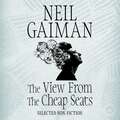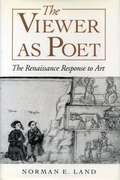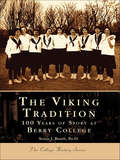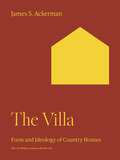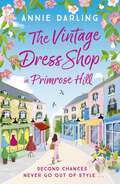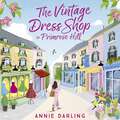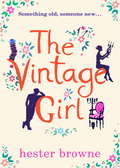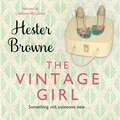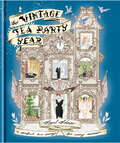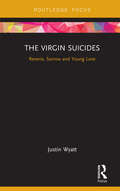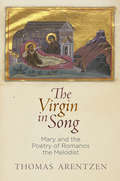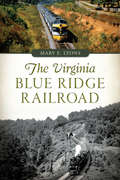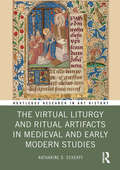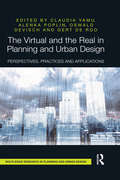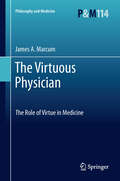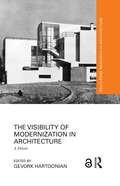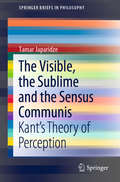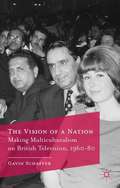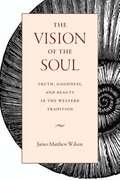- Table View
- List View
The View from the Cheap Seats: Selected Nonfiction
by Neil GaimanThe View from the Cheap Seats draws together myriad non-fiction writing by international phenomenon and Sunday Times bestselling author Neil Gaiman. From Make Good Art, the speech that went viral, to pieces on artists and legends including Terry Pratchett and Lou Reed, the collection offers a glimpse into the head and heart of one of the most acclaimed writers of our time.'Literature does not occur in a vacuum. It cannot be a monologue. It has to be a conversation'Welcome to the conversation. Neil Gaiman fled the land of journalism to find truths through storytelling and sanctuary in not needing to get all the facts right. Of course, the real world continued to make up its own stories around him, and he has responded over the years with a wealth of ideas and introductions, dreams and speeches. Here 'we can meet the writer full on' (Stephen Fry) as he opens our minds to the people he admires and the things he believes might just mean something - and makes room for us to join the conversation too.(P)2016 HarperCollins Digital
The Viewer as Poet: The Renaissance Response to Art
by Norman E. LandThis is a book on Renaissance aesthetics. Renaissance art lovers comment on the famous works of art of their time.
The Viewpoints Book
by Tina Landau Anne BogartThe Viewpoints is a technique of improvisation that grew out of the postmodern dance world. It was first articulated by choreographer Mary Overlie, who broke down the two dominant issues performers deal with--space and time--into six categories. Since that time, directors Anne Bogart and Tina Landau have expanded her notions and adapted them for actors to function together spontaneously and intuitively and to generate bold, theatrical work.The Viewpoints are a set of names given to certain principles of movement through time and space--they constitute a language for talking about what happens on stage. Coupling this with Composition, which is the practice of selecting and arranging the separate components of theatrical language into a cohesive work of art, provides theatre artists with an important new tool for creating and understanding their art form.Primarily intended for the many theatre artists who, in the last several years, have become intrigued with Viewpoints yet have had no single source to refer to in their investigations. It can also be used by anyone with a general interest in collaboration and the creative process, whether in art, business or daily life.Anne Bogart is Artistic Director of the SITI Company, which she founded with Japanese director Tadashi Suzuki in 1992. She is the recipient of two OBIE Awards and a Bessie Award, and is an associate professor at Columbia University. Her recent works include Alice's Adventures; Bobrauschenbergamerica; Small Lives, Big Dreams; Marathon Dancing; and The Baltimore Waltz.Tina Landau, noted director and playwright, whose original work includes Space (Time magazine 10 Best), Dream True (with composer Ricky Ian Gordon) and Floyd Collins (with composer Adam Guettel), which received the Lucille Lortel Award for Best Musical, an OBIE Award and seven Drama Desk nominations. She has been an ensemble member of the Steppenwolf Theatre Company since 1997.
The Viking Tradition: 100 Years of Sports at Berry College (Campus History)
by Susan J. Bandy Ph.D.In 1902, Martha Berry founded the Industrial School for Boys to educate the children of the Southern Appalachian Mountains, and in 1909 the school admitted women. The institution grew from a mountain industrial school to a two-year college in its first twenty-four years, became a four-year college in 1930, and has since become one of the leading liberal arts colleges in the South.This volume portrays, in word and image, the role of sports at Berry College throughout its 100-year history. Situating athletics within the social and cultural life of the college, the book includes both intramural and intercollegiate sport, and traces the evolution of the Viking tradition as it both parallels and reflects the development of sport in the United States. The story begins with the recreational and leisure activities of the early years of the school and traces the continuation of the sporting spirit from the days of the "Silver and the Blue" through the post-war "Blue Jacket" tradition, and ends with the Viking years of the last four decades. Of notable interest in the book is the development of the women's sports program, which has brought four national titles to the college; the importance of soccer to the college; the well-rounded intercollegiate program, which currently fields teams in seven sports; and an excellent intramural program.
The Villa: Form and Ideology of Country Houses (The A. W. Mellon Lectures in the Fine Arts #34)
by James S. AckermanA classic account of the villa—from ancient Rome to the twentieth century—by “the preeminent American scholar of Italian Renaissance architecture” (Architect’s Newspaper)In The Villa, James Ackerman explores villa building in the West from ancient Rome to twentieth-century France and America. In this wide-ranging book, he illuminates such topics as the early villas of the Medici, the rise of the Palladian villa in England, and the modern villas of Frank Lloyd Wright and Le Corbusier. Ackerman uses the phenomenon of the “country place” as a focus for examining the relationships between urban and rural life, between building and the natural environment, and between architectural design and social, cultural, economic, and political forces. “The villa,” he reminds us, “accommodates a fantasy which is impervious to reality.” As city dwellers idealized country life, the villa, unlike the farmhouse, became associated with pleasure and asserted its modernity and status as a product of the architect’s imagination.
The Vintage Dress Shop in Primrose Hill: A sparkling and feel-good romantic read to warm your heart (A Vintage Dress Shop Romance)
by Annie Darling'The sweetest, most delicious book . . . Such a gorgeous love story' Marian Keyes'Funny and heartwarming with great characters' Reader review ⭐⭐⭐⭐⭐'Absolutely gorgeous, swoon worthy romance' Reader review ⭐⭐⭐⭐⭐ 👗Second chances never go out of style...👗 Sophy Stevens always thought she would have everything sorted by the time she was thirty. Instead, she is freshly fired, recently dumped and sleeping on her mum's sofa. So when her absent dad offers her a job at his vintage clothes shop in Primrose Hill, it's one she can't refuse. It will only be for a few months until she is back on her feet, after all.But the Vintage Dress Shop is more magical than she could have even imagined, full of preloved fashion from a 1950s wedding dress to the glittering gems sourced by jeweller Charles. In spite of herself, Sophy starts to fall in love with the store and the process of matching the perfect item with every customer.With each new treasure Sophy uncovers, she begins to wonder if, like these vintage clothes, the store is the key to her second chance... and then there's Charles, who might just end up mending her broken heart...Let Annie Darling sweep you off your feet with this heartwarming and romantic novel, perfect for fans of Katie Fforde and Phillipa Ashley. Everyone is falling in love with Annie Darling:'Heartwarming and compelling. A wonderful read which was difficult to put down... Great characters and a lovely romantic story which touches the heart' Reader review ⭐⭐⭐⭐⭐'The most uplifting, sumptuously indulgent, romantic joy of a book... It tugged all my heartstrings and held me captive until the last, perfect page' Cressida McLaughlin'An absolute delight! I also loved the debonair love interest... It was so nice to see someone pick themselves up and rise from the ashes in such beautiful surroundings surrounded by all these amazing clothes, I loved it!' Reader review ⭐⭐⭐⭐⭐ 'This is the feel good book you must read... With an array of fabulous characters and the perfect ending that made me squeal with delight this warm and charming story will have you enchanted' Nina Pottell
The Vintage Dress Shop in Primrose Hill: A sparkling and feel-good romantic read to warm your heart (A Vintage Dress Shop Romance)
by Annie Darling'The sweetest, most delicious book . . . Such a gorgeous love story' Marian Keyes'Funny and heartwarming with great characters' Reader review ⭐⭐⭐⭐⭐'Absolutely gorgeous, swoon worthy romance' Reader review ⭐⭐⭐⭐⭐ 👗Second chances never go out of style...👗 Sophy Stevens always thought she would have everything sorted by the time she was thirty. Instead, she is freshly fired, recently dumped and sleeping on her mum's sofa. So when her absent dad offers her a job at his vintage clothes shop in Primrose Hill, it's one she can't refuse. It will only be for a few months until she is back on her feet, after all.But the Vintage Dress Shop is more magical than she could have even imagined, full of preloved fashion from a 1950s wedding dress to the glittering gems sourced by jeweller Charles. In spite of herself, Sophy starts to fall in love with the store and the process of matching the perfect item with every customer.With each new treasure Sophy uncovers, she begins to wonder if, like these vintage clothes, the store is the key to her second chance... and then there's Charles, who might just end up mending her broken heart...Let Annie Darling sweep you off your feet with this heartwarming and romantic novel, perfect for fans of Katie Fforde and Phillipa Ashley. Everyone is falling in love with Annie Darling:'Heartwarming and compelling. A wonderful read which was difficult to put down... Great characters and a lovely romantic story which touches the heart' Reader review ⭐⭐⭐⭐⭐'The most uplifting, sumptuously indulgent, romantic joy of a book... It tugged all my heartstrings and held me captive until the last, perfect page' Cressida McLaughlin'An absolute delight! I also loved the debonair love interest... It was so nice to see someone pick themselves up and rise from the ashes in such beautiful surroundings surrounded by all these amazing clothes, I loved it!' Reader review ⭐⭐⭐⭐⭐ 'This is the feel good book you must read... With an array of fabulous characters and the perfect ending that made me squeal with delight this warm and charming story will have you enchanted' Nina Pottell
The Vintage Dress Shop in Primrose Hill: A sparkling and feel-good romantic read to warm your heart (The Vintage Dress Shop)
by Annie DarlingSecond chances never go out of style . . .The heartwarming and romantic new novel from Annie Darling - perfect for fans of Cressida McLaughlin and Holly Hepburn!The Vintage Dress Shop, in London's Primrose Hill, is a treasure trove of beautiful, preloved clothes, just waiting for a second chance to be loved again... Sophy Stevens is moving to Australia. Turning thirty has found her unexpectedly out of a job, out of a relationship, and just in need of Something Different - and Australia, where she can finally meet her grandparents and surprise them on their wedding anniversary, looks like the perfect answer . . . if she can save up the money for the plane ticket. So when her feckless, absent dad Johnno offers her a job at his vintage clothes shop in Primrose Hill, she can't turn it down. It'll only be for a few months, after all. But the Vintage Dress Shop turns out to be a treasure trove of gorgeous preloved clothes, from a 1930s cocktail gown to a never-worn 50s wedding dress, and despite the disapproval of the snooty manager, Phoebe, Sophy starts to fall in love with vintage fashion. And then there's Charles Radley, the debonair gemstone specialist with exquisite tailoring, cheekbones sharp enough to cut glass, and enough charm to throw Sophy's plans wildly off course. . .(P)2023 Hodder & Stoughton Limited
The Vintage Fashion Illustration Manual
by Edith YoungOriginally published in 1919 as Student's Manual of Fashion Drawing, this antique volume represents an authentic guide to fashion illustration in the years between the Edwardian era and the Jazz Age. Readers with an interest in vintage fashion will be fascinated by the text and illustrations, which explain everything from drawing the basic human form to stylistic details of collars, shoes, parasols, hats, and other garments and accessories. Author Edith Young, a seasoned professional in art and fashion illustration, presents detailed instructions accompanied by numerous images. Her careful explanations of fundamental principles provide students with the means for practice. Lessons on drawing basic shapes, human forms, and proportions in garments offer timeless advice, and stylistic details supply flourishes specific to the period covered by this manual. A great way to learn how to draw vintage fashion from a genuine voice of the era, this volume is a valuable companion for fashion students, artists, costumers, vintage clothing buyers, and lovers of bygone fashions.
The Vintage Girl: a sweeping romance that will have you laughing out loud
by Hester Browne'What a delicious, witty story, I loved it!' Sophie KinsellaThe last thing Evie expects to find in the Scottish Highlands is love . . .When Evie Nicholson is asked to visit Kettlesheer Castle in Scotland to archive the family heirlooms, she jumps at the chance. Evie's passion for antiques means that, for her, the castle is a treasure trove of mysteries just waiting to be uncovered.But in each heirloom lies a story, and in the course of her investigations Evie stumbles upon some long-buried family secrets. Add handsome, gloomy heir Robert McAndrew and a traditional candlelit gala to the mix, and Evie's heart is sent reeling with an enthusiasm that may just extend beyond the Kettlesheer silver . . .'Deliciously addictive, feel-good comedy' Cosmopolitan 'Funny and flirty, we guarantee you'll devour this book in one sitting' GlamourWHAT READERS ARE SAYING ABOUT THE VINTAGE GIRL'I am off to buy more from Hester Browne!' *****'A sweeping romance that will have you laughing out loud' *****'A must for all romantic history lovers' *****'Funny, sweet, romantic' *****'Couldn't ask for more!' *****
The Vintage Girl: a sweeping romance that will have you laughing out loud
by Hester BrowneWhen Evie Nicholson is asked to visit Kettlesheer Castle in Scotland to archive the family heirlooms, she jumps at the chance. Evie's passion for antiques means that, for her, the castle is a treasure trove of mysteries just waiting to be uncovered. But in each heirloom lies a story, and in the course of her investigations Evie stumbles upon some long-buried family secrets. Add handsome, gloomy heir Robert McAndrew and a traditional candlelit gala to the mix, and Evie's heart is sent reeling with an enthusiasm that may just extend beyond the Kettlesheer silver...(P)2014 WF Howes Ltd
The Vintage Tea Party Year
by Angel Strawbridge''Elegant images and illustrations adorn the pages of Angel Adoree's delightful book, which is brimming with style and recipe ideas'' -The Times"Party like its 1949" - Irish IndependentAngel Adoree cordially invites you to accompany her on a journey to create your perfect vintage tea party year!Angel is the founder of The Vintage Patisserie, a popular vintage hosting company offering bespoke tea parties from a bygone era, delivering everything from music, makeovers and - of course - a customised menu of tea party treats that elevate any function into a swanky soiree. The Vintage Tea Party Year takes you on twelve months of parties,celebrations and tea-time treats as well as introducing more games and craft projects for your chosen theme.See the New Year in with vintage style, make Valentine's Day extra special, give every child their dream tea party, find inspiration for weddings and baby showers, be the talk of the town with your own summer street party and wrap up for winter with a vintage-inspired Christmas. Angel's inimitable style will take you on a seasonal journey and help you put on the perfect tea party whatever the occasion.Your vintage year includes...INTRODUCTION Hello! Can you tell already that the era of "vintage" is a considerable source of inspiration for me? On these pages, I explain how the past has influenced mypresent and future, and suggest how to use this book to plan your own vintage-style party.NEW YEAR'S EVE TEA PARTY To end your year on a high note and start the next as you mean to go on, look no further -that is, if you intend to go on in decadence, glamour, indulgence... This chapter showcasesmy most fabulous New Year's Eve party ideas, so that you can give the event the attention itdeserves, then let your hair down in style (or go for an uber-elegant vintage up-do perhaps?).CHILDREN'S TEA PARTY Roll up, roll up! Who doesn't love the circus, what with its bright colours, crazy costumes andgiddy, gleeful sense of fun? The spirit of the circus plus yummy treats dreamed up in kiddyheaven equals a spectacular party to live on in the memories of kids and grown-up kids alike!COMING OF AGE TEA PARTY When a girl comes of age, it's definitely something worth celebrating. And a young lady shouldbegin womanhood in a sassy dress with a chic hair-do, wearing a lady-like pair of gloves inwhich to raise her mocktail glass as she shares a toast to her glorious life ahead.TEA FOR TWO Love is in the air (and in the hair...). Whether it's for Valentine's Day, or for anyday on which your passions are running high, my suggestions for how toromance the man in your life are sure to make him swoon!HEN TEA PARTY When a treasured girlfriend leaves the single life behind, it's time to pull out all thestops. This party must be momentous, and the name of the game is sheerindulgence, naughtiness and uproarious fun. Bring a touch of the cabaretto your night of decadence and it's bound to be fabulous!
The Violence of the Image: Photography and International Conflict (International Library Of Visual Culture Ser.)
by Liam KennedyPhotography has visualized international relations and conflicts from the midnineteenth century onwards and continues to be an important medium in framing the worlds of distant, suffering others. Although photojournalism has been challenged in recent decades, claims that it is dead are premature. The Violence of the Image examines the roles of image producers and the functions of photographic imagery in the documentation of wars, violent conflicts and human rights issues; tackling controversial ideas such as 'witnessing', the making of appeals based on displays of human suffering and the much-cited concept of 'compassion fatigue'. In the twenty-first century, the advent of digital photography, camera phones and socialmedia platforms has altered the relationship between photographers, the medium and the audience- as well as contributing to an ongoing blurring of the boundaries between news and entertainment and professional and amateur journalism. The Violence of the Image explores how new vernacular and artistic modes of photographic production articulate international friction.This innovative, timely book makes a major contribution to discussions about the power of the image in conflict.
The Virgin Suicides: Reverie, Sorrow and Young Love (Cinema and Youth Cultures)
by Justin WyattBased on the best-selling novel by Jeffrey Eugenides, The Virgin Suicides is director Sofia Coppola’s evocative debut feature of young love, sex, loss and family pressures in mid-1970s America. Acclaimed by both critics and audiences on release, the film is now viewed as a remarkable and bold feature by a significant female director addressing many issues related to youth, female sexuality and family. This book helps readers understand the film’s significance and the stylistic and storytelling choices made by director Coppola. The analysis of the film occurs around three interlocking arguments: the unusual structuring absence in the film, the intricate manner through which music is used in the drama, communication and character creation, and the film’s careful and specific referencing of advertising in the 1970s (the decade of the film’s narrative). The film’s enigmatic structure and unique storytelling devices and their relationship to female adolescence, sexuality and ideology are also considered in depth. Without solving the mysteries of the film, the book is designed to uncover the reasons why the film continues to fascinate viewers so many years after its release.
The Virgin in Song: Mary and the Poetry of Romanos the Melodist (Divinations: Rereading Late Ancient Religion)
by Thomas ArentzenAccording to legend, the Virgin appeared one Christmas Eve to an artless young man standing in one of Constantinople's most famous Marian shrines. She offered him a scroll of papyrus with the injunction that he swallow it, and following the Virgin's command, he did so. Immediately his voice turned sweet and gentle as he spontaneously intoned his hymn "The Virgin today gives birth." So was born the career of Romanos the Melodist (ca. 485-560), one of the greatest liturgical poets of Byzantium, author of at least sixty long hymns, or kontakia, that were chanted during the night vigils preceding major feasts and festivals.In The Virgin in Song, Thomas Arentzen explores the characterization of Mary in these kontakia and the ways in which the kontakia echoed the cult of the Virgin. He focuses on three key moments in her story as marked in the liturgical calendar: her encounter with Gabriel at the Annunciation, her child's birth at Christmas, and the death of her son on Good Friday. Consistently, Arentzen contends, Romanos counters expectations by shifting emphasis away from Christ himself to focus on Mary—as the subject of the erotic gaze, as a breastfeeding figure of abundance and fertility, and finally as an authoritatively vocal woman who conveys the secrets of her son and the joys of the resurrection.Through his hymns, Romanos inspired an affective relationship between Mary and his audience, bringing the human and the holy into dialogue. By plumbing her emotional depths, the poet traces her process of understanding as she apprehends the mysteries that she embodies. By giving her a powerful voice, he grants subjectivity to a maiden who becomes a mediator. Romanos shaped a figure, Arentzen argues, who related intimately to her flock in a formative period of Christian orthodoxy.
The Virginia Blue Ridge Railroad (Transportation)
by Mary E. LyonsIn 1849, Virginia began a bold railroad expansion toward the Ohio River and its lucrative trade connections. The project's plan covered 423 miles and called for piercing two mountain chains with three railroads. The Blue Ridge Railroad was the shortest of these but crossed the most mountainous terrain. At times, hired slaves, who prepared the tracks, and Irish immigrants, who blasted the tunnels, faced challenges that seemed almost insurmountable. Many were killed by explosions and falling rock. Those deaths often resulted in labor strikes. The unrest slowed progress and haunted chief engineer Claudius Crozet for seven years. In this first full-length history of the Blue Ridge Railroad, award-winning author Mary E. Lyons uses a wealth of historical documents to describe construction on what Crozet called "dangerous ground."
The Virtual Life of Film
by D. N. RodowickAs almost (or, truly, virtually) every aspect of making and viewing movies is replaced by digital technologies, even the notion of "watching a film" is fast becoming an anachronism. With the likely disappearance of celluloid film stock as a medium, and the emergence of new media competing for an audience, what will happen to cinema--and to cinema studies? In the first of two books exploring this question, D. N. Rodowick considers the fate of film and its role in the aesthetics and culture of moviemaking and viewing in the twenty-first century. Here Rodowick proposes and examines three different critical responses to the disappearance of film in relation to other time-based media, and to the study of contemporary visual culture. Film, he suggests, occupies a special place in the genealogy of the arts of the virtual: while film disappears, cinema persists--at least in the narrative forms imagined by Hollywood since 1915. Rodowick also observes that most so-called "new media" are fashioned upon a cinematic metaphor. His book helps us see how digital technologies are serving, like television and video before them, to perpetuate the cinematic as the mature audiovisual culture of the twentieth century--and, at the same time, how they are preparing the emergence of a new audiovisual culture whose broad outlines we are only just beginning to distinguish.
The Virtual Liturgy and Ritual Artifacts in Medieval and Early Modern Studies (Routledge Research in Art History)
by Katharine D. ScherffExamining the history of altar decorations, this study of the visual liturgy grapples with many of the previous theoretical frameworks to reveal the evolution and function of these ritual objects. Using an interdisciplinary approach, this book uses traditional ar- historical methodologies and media technology theory to reexamine ritual objects. Previous analysis has not considered the in-between nature of these objects as deliberate and virtual conduits to the divine. The liturgy, the altarpiece, the altar environment, relics, and their reliquaries are media. In a series of case studies, several objects tell a different story about culture and society in medieval Europe. In essence, they reveal that media and media technologies generate and modulate the individual and collective structure of feelings of sacredness among assemblages of humans and nonhumans. The book will be of interest to scholars working in art history, medieval studies, early modern studies, and architectural history.
The Virtual and the Real in Planning and Urban Design: Perspectives, Practices and Applications
by Gert De Roo Oswald Devisch Claudia Yamu Alenka PoplinThe Virtual and the Real in Planning and Urban Design: Perspectives, Practices and Applications explores the merging relationship between physical and virtual spaces in planning and urban design. Technological advances such as smart sensors, interactive screens, locative media and evolving computation software have impacted the ways in which people experience, explore, interact with and create these complex spaces. This book draws together a broad range of interdisciplinary researchers in areas such as architecture, urban design, spatial planning, geoinformation science, computer science and psychology to introduce the theories, models, opportunities and uncertainties involved in the interplay between virtual and physical spaces. Using a wide range of international contributors, from the UK, USA, Germany, France, Switzerland, Netherlands and Japan, it provides a framework for assessing how new technology alters our perception of physical space.
The Virtuous Physician
by James A. MarcumAlthough modern medicine enjoys unprecedented success in providing excellent technical care, many patients are dissatisfied with the poor quality of care or the unprofessional manner in which physicians sometimes deliver it. Recently, this patient dissatisfaction has led to quality-of-care and professionalism crises in medicine. In this book, the author proposes a notion of virtuous physician to address these crises. He discusses the nature of the two crises and efforts by the medical profession to resolve them and then he briefly introduces the notion of virtuous physician and outlines its basic features. Further, virtue theory is discussed, along with virtue ethics and virtue epistemology, and specific virtues, especially as they relate to medicine. The author also explores the ontological priority of caring as the metaphysical virtue for grounding the notion of virtuous physician, and two essential ontic virtues--care and competence. In addition to this, he examines the transformation of competence into prudent wisdom and care into personal radical love to forge the compound virtue of prudent love, which is sufficient for defining the virtuous physician. Lastly, two clinical case stories are reconstructed which illustrate the various virtues associated with medical practice, and it is discussed how the notion of virtuous physician addresses the quality-of-care and professionalism crises.
The Visibility of Modernization in Architecture: A Debate (Routledge Research in Architecture)
by Gevork HartoonianThis edited collection explores the visibility of modernization in architecture produced in different capitalist regions across the world and provides readers with a historico-theoretical and historico-geographical discussion. Focusing on a particular building type, an influential architect’s work, as well as relevant texts and documents, each chapter addresses the many facets of "delay" which are central to the problematization of capitalism’s progressive dissemination of technological and aesthetic regimes of modernism. This collection underlines the centrality of temporality for a critical understanding of colonialism, modernism, and capitalism. The book is primarily concerned with the historical timeline, the tangential point when a nation enters modernization processes. In exploring modernism in diverse regions such as East Asia, Pacific, Eastern Europe, and Iran, each chapter addresses the historiographic and architectonic unfolding of modernization beyond the western hemisphere. The exploration of these diverse case-studies will be of interest to students of architecture and researchers working on the collision of temporalities and the subject's critical importance for different country’s built-environments.
The Visibility of Modernization in Architecture: A Debate (Routledge Research in Architecture)
by Gevork HartoonianThis edited collection explores the visibility of modernization in architecture produced in different capitalist regions across the world and provides readers with a historico-theoretical and historico-geographical discussion.Focusing on a particular building type, an influential architect’s work, as well as relevant texts and documents, each chapter addresses the many facets of "delay" which are central to the problematization of capitalism’s progressive dissemination of technological and aesthetic regimes of modernism. This collection underlines the centrality of temporality for a critical understanding of colonialism, modernism, and capitalism. The book is primarily concerned with the historical timeline, the tangential point when a nation enters modernization processes. In exploring modernism in diverse regions such as East Asia, Pacific, Eastern Europe, and Iran, each chapter addresses the historiographic and architectonic unfolding of modernization beyond the western hemisphere.The exploration of these diverse case-studies will be of interest to students of architecture and researchers working on the collision of temporalities and the subject's critical importance for different country’s built-environments.Chapter 13 of this book is freely available as a downloadable Open Access PDF at http://www.taylorfrancis.com under a Creative Commons Attribution-Non Commercial-No Derivatives (CC BY-NC-ND) 4.0 license.
The Visible, the Sublime and the Sensus Communis: Kant’s Theory of Perception (SpringerBriefs in Philosophy)
by Tamar JaparidzeThis book argues that Kant develops a theory of perception in the Critique of Judgment from which one can redefine his entire project, viewing and using aesthetics as its backbone, from the transcendental aesthetic of the First Critique to the Critique of Taste in the Third. The author shows us how Kant exonerates the role of faculties that account for such judgments linked by inner senses, inclusive of sensus communis. By re-examining the role of the aesthetic within Kant's critical philosophy, the compelling force of the aesthetic turn is revealed in modern philosophy. The text includes Heidegger’s, Hegel’s and Diderot's complex relationship to Kant in this context.This text provides important scholarship for those interested in the Kantian influence on German Idealism, the aesthetic turn in the continental tradition, especially the Frankfurt school, and more generally, those interested in the encounter between philosophy and art in this historical context.
The Vision of a Nation
by Gavin SchafferTelling the stories behind television's approaches to race relations, multiculturalism and immigration in the 'Golden Age' of British television, the book focuses on the 1960s and 1970s and argues that the makers of television worked tirelessly to shape multiculturalism and undermine racist extremism.
The Vision of the Soul: Truth, Beauty, and Goodness in the Western Tradition
by James Matthew WilsonStory-telling is foundational to the forms of the fine arts, but it is no less foundational to human reason. Human life in turn constitutes a specific kind of form―a story form. The ancient conception of human life as a pilgrimage to beauty itself is one that we can fully embrace only if we see the essential correlation between reason and story and the essential convertibility of truth, goodness and beauty in beauty. By turns a study in fundamental ontology, aesthetics, and political philosophy, Wilson's book invites its readers to a renewal of the West's intellectual tradition.
